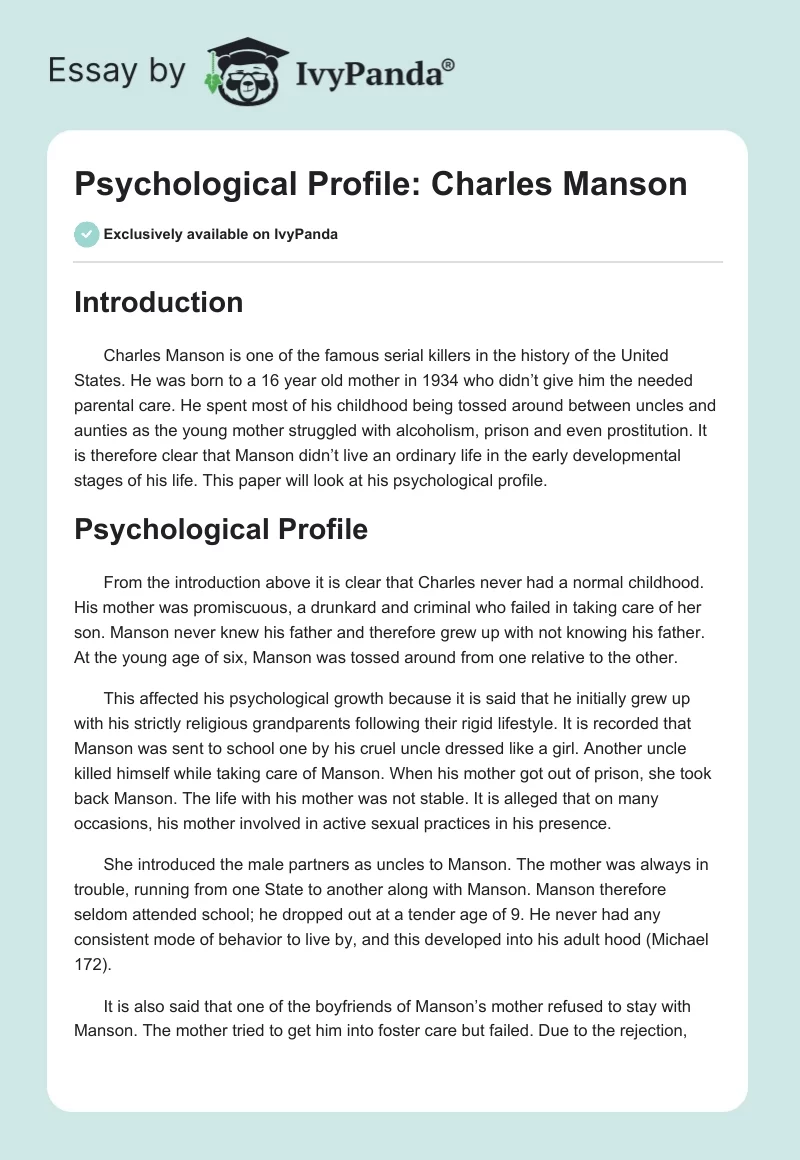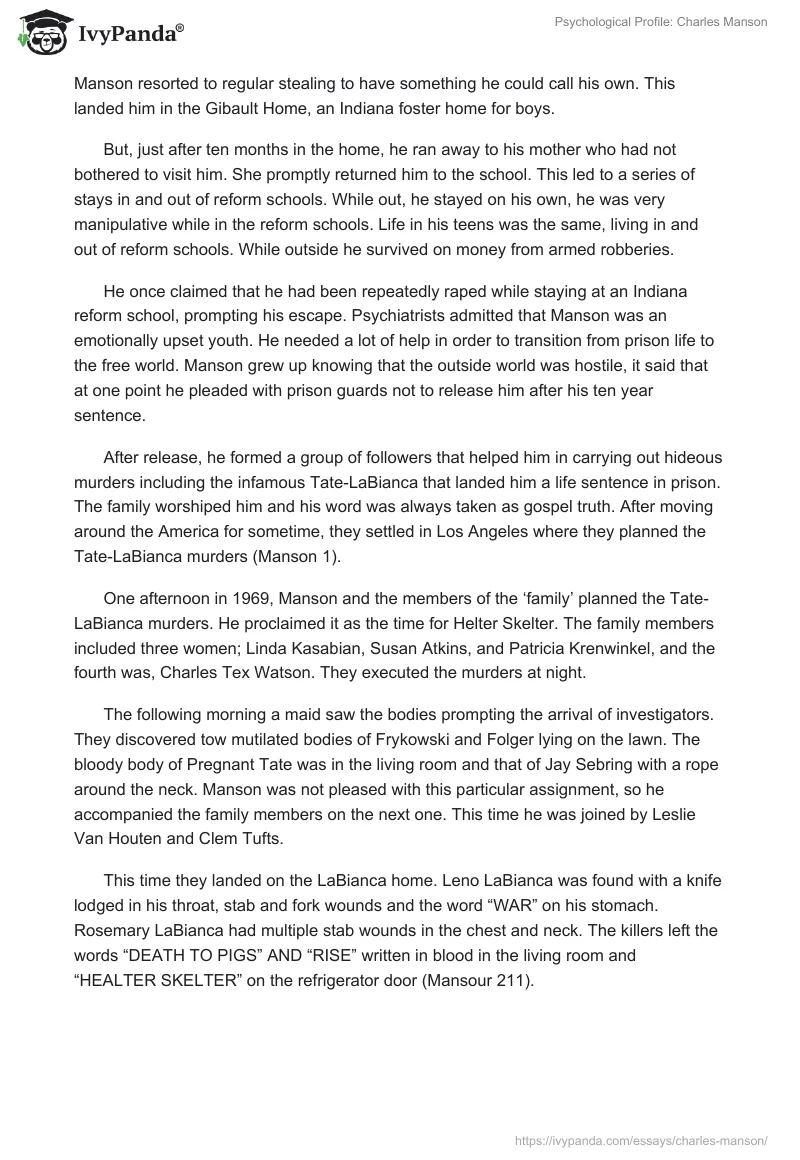Introduction
Charles Manson is one of the famous serial killers in the history of the United States. He was born to a 16 year old mother in 1934 who didn’t give him the needed parental care. He spent most of his childhood being tossed around between uncles and aunties as the young mother struggled with alcoholism, prison and even prostitution. It is therefore clear that Manson didn’t live an ordinary life in the early developmental stages of his life. This paper will look at his psychological profile.
Psychological Profile
From the introduction above it is clear that Charles never had a normal childhood. His mother was promiscuous, a drunkard and criminal who failed in taking care of her son. Manson never knew his father and therefore grew up with not knowing his father. At the young age of six, Manson was tossed around from one relative to the other.
This affected his psychological growth because it is said that he initially grew up with his strictly religious grandparents following their rigid lifestyle. It is recorded that Manson was sent to school one by his cruel uncle dressed like a girl. Another uncle killed himself while taking care of Manson. When his mother got out of prison, she took back Manson. The life with his mother was not stable. It is alleged that on many occasions, his mother involved in active sexual practices in his presence.
She introduced the male partners as uncles to Manson. The mother was always in trouble, running from one State to another along with Manson. Manson therefore seldom attended school; he dropped out at a tender age of 9. He never had any consistent mode of behavior to live by, and this developed into his adult hood (Michael 172).
It is also said that one of the boyfriends of Manson’s mother refused to stay with Manson. The mother tried to get him into foster care but failed. Due to the rejection, Manson resorted to regular stealing to have something he could call his own. This landed him in the Gibault Home, an Indiana foster home for boys.
But, just after ten months in the home, he ran away to his mother who had not bothered to visit him. She promptly returned him to the school. This led to a series of stays in and out of reform schools. While out, he stayed on his own, he was very manipulative while in the reform schools. Life in his teens was the same, living in and out of reform schools. While outside he survived on money from armed robberies.
He once claimed that he had been repeatedly raped while staying at an Indiana reform school, prompting his escape. Psychiatrists admitted that Manson was an emotionally upset youth. He needed a lot of help in order to transition from prison life to the free world. Manson grew up knowing that the outside world was hostile, it said that at one point he pleaded with prison guards not to release him after his ten year sentence.
After release, he formed a group of followers that helped him in carrying out hideous murders including the infamous Tate-LaBianca that landed him a life sentence in prison. The family worshiped him and his word was always taken as gospel truth. After moving around the America for sometime, they settled in Los Angeles where they planned the Tate-LaBianca murders (Manson 1).
One afternoon in 1969, Manson and the members of the ‘family’ planned the Tate-LaBianca murders. He proclaimed it as the time for Helter Skelter. The family members included three women; Linda Kasabian, Susan Atkins, and Patricia Krenwinkel, and the fourth was, Charles Tex Watson. They executed the murders at night.
The following morning a maid saw the bodies prompting the arrival of investigators. They discovered tow mutilated bodies of Frykowski and Folger lying on the lawn. The bloody body of Pregnant Tate was in the living room and that of Jay Sebring with a rope around the neck. Manson was not pleased with this particular assignment, so he accompanied the family members on the next one. This time he was joined by Leslie Van Houten and Clem Tufts.
This time they landed on the LaBianca home. Leno LaBianca was found with a knife lodged in his throat, stab and fork wounds and the word “WAR” on his stomach. Rosemary LaBianca had multiple stab wounds in the chest and neck. The killers left the words “DEATH TO PIGS” AND “RISE” written in blood in the living room and “HEALTER SKELTER” on the refrigerator door (Mansour 211).
Forensic Psychology
In 1969 September 1st, a 22 caliber Longhorn revolver was discovered by a ten-year old boy under a bush near his home in Sherman Oaks. The LAPD was notified by his parents; they picked up the gun, but failed to connect it to the Tate Murders. Barker Ranch located in a remote area to the south of Death Valley National Monument was raided by Inyo County officers in October. This resulted to the arrest of 24 members of the ‘family’ including Manson on grand theft and arson charges.
While in her prison dormitory in Los Angeles on November 6th, Atkins confessed to a fellow inmate, Virginia Graham, about the Tate murders. She showed no remorse and even went further to disclose that there was a list of celebrities to be killed by the family members in the future. The story reached another inmate friend of Graham’s called Ronnie and through her the LAPD got wind of it (Manson Trial 1).
This happened when another group of detectives was following the LaBianca case. After having heard that the Straight Satan biker’s group may have something about the murders, they interviewed Al Springer, one of the group’s members who had refused to be recruited by Manson. Springer revealed to the detectives that Manson had said something about knocking off five people in August at Spahn Ranch. He even told them that Manson had said that the killers had written smoothing in blood on the refrigerator.
This was a cue although; the detectives didn’t understand why someone could confess to killing to someone he barely knew. Another member of the group, DeCarlo, confirmed that Manson was behind the murders when he told the detectives that he overheard a member of Manson’s ‘family’ bragging about killing five piggies. He also claimed that Manson had asked him what can be used in decomposing a body (Manson Trial 1).
In 1969 November 18th, Vincent Bugliosi was selected the chief prosecutor in the Tate-LaBianca case. He joined in the search at the Spahn Ranch where 22 caliber bullets and canyon shell casing used by the ‘family’ for target practice were found. The Barker Ranch was searched the following day. Here, a small cabinet where Manson was found hidden during the raid in October, was found under the sink. Magazines from WW II with articles on Hitler were found on the bus abandoned by the ‘family’.
The 22 caliber revolver found by the ten-year old boy, the 22 caliber bullets found at the Spahn Ranch, the account of Susan’s prison confession by Ronnie, Graham’s inmate friend, the tips from the members of the Straight Satan biker’s group and the interviews carried out on the members of the ‘family’, the forensic experts finally identified the five individuals who took part in the actual murders at the Tate and LaBianca families.
The suspects were four women and one man; Susan, Patricia, Leslie, Linda, and Charles Watson, all in their twenties. Atkins remained in her prison cell in Los Angeles, Leslie was picked up in California for questioning, a local sheriff in Texas arrested Watson, and Patricia was caught in Mobile Alabama, while Linda surrendered voluntarily to the local police in New Hampshire (Doug 1).
Conclusion
Testimony from persons present during the murders was needed to enable conviction of some of the suspects. A deal between the D.A. and Atkins attorney was reached, Susan’s testimony for a promise not to seek the death penalty and other considerations if she continued to cooperate with the detectives.
Appearing before a Grand Jury in December, Atkins gave her testimony. She described everything as it happened, from planning to execution. After the testimony, murder indictments were returned against Atkins, Linda, Patricia, Leslie, Watson and Manson.
Works Cited
Doug, Linder. (2002). The Charles Manson (Tate-LaBianca Murder) Trial. Law. Web.
Manson Trial. Charles Manson Trial: 1970-71 – Atkins Reverses Course, A “helter Skelter” Scheme, Case Draws Presidential Remark, Manson Speaks. Law, n.d. Web.
Manson, Charles. Charles Manson the Early Years. Karisable, 2006. Web.
Mansour, David. From Abba to Zoom: a pop culture encyclopedia of the late 20th century. New York: Andrews McMeel, 2005. Print.
Michael, Newton. The encyclopedia of serial killers. New York: InfoBase, 2006. Print.


